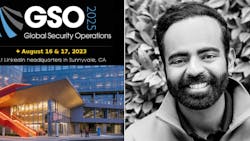GSO 2025 Q&A: Closely examining artificial intelligence
Editor’s note: This is the fourth in a series of interviews regarding the upcoming GSO 2025 event being held August 16-17, 2023 at the LinkedIn Global Headquarters in the heart of Silicon Valley, Calif. The event is named with a future date because it takes a 3- to 5-year look ahead at where security leadership and security technology are going. Registration is open now.
Managing Editor John Dobberstein spoke recently with Shikhar Shrestha, CEO of Ambient AI, one of the technology participants in the GSO Event. John inquired about the role of AI in the physical security domain.
SIW: How is AI critical in solving the biggest challenges facing the physical security domain?
Shrestha: Like other industries that AI is disrupting, AI is really aimed at solving the human-based limitations. To date, computer vision technologies and integrated systems have begun equipping security operators with critical information in a more streamlined fashion. However, they haven’t been able to truly convert security operations from a reactive to a proactive posture. Naturally, most companies – ours included – are addressing the “low-hanging fruit” AI can provide. But it shouldn’t stop there, and we haven’t.
AI can and should be used more effectively than it has been to advance security operations, which is why a strong focus of ours is operationalizing AI – which includes the people, process and technology elements – to achieve the proactive and preemptive capabilities that are ultimately desired. Exactly how to do that is what we will explore in depth in the GSO event.
SIW: Why are large enterprises investing in AI-powered visual intelligence platforms right now?
All companies face the never-ending task of continually updating security point solutions to keep up with innovation. Due to the massive investment large organizations incur during every upgrade, they need to keep an eye fixed on the future landscape.
Enterprises are starting to view AI-powered technologies as the tip of the spear of their security infrastructure. That’s because AI has now proven its ability to analyze data flowing through a wide range of systems to uncover the start of real incidents that might have been missed for various reasons.
However, the value we’re seeing now is just the beginning. AI will continue to learn and improve, meaning when you plug it in, you won’t need to keep ripping and replacing it to see tangible improvements to your security posture. It’s technology that ends the massive rip-and-replace scenarios that large enterprises want to invest in.
SIW: What are the potential applications of an AI platform beyond what physical security systems do?
Consider the deep-learning capabilities of our AI platform, which can be trained to look for just about anything. We’re integrating with the “eyes” – security cameras – within and around organizations. What kinds of activities and situations would be helpful for the company to know about? What should we be looking for?
Looking just slightly beyond typical security system capabilities, our AI is already helping unlock critical insights.
Essentially, it is running continuous risk assessments that help teams prioritize security resources and make informed decisions about risk mitigation. This includes finding gaps in security, identifying optimal guard routes and deployment, and providing data needed to build robust security policies and procedures.
Looking completely beyond typical security technology, workplace and facility teams are very focused on returning to office right now.
These teams have very limited data, if any, to support the major real estate expenditures decisions they’re currently grappling with. Security cameras can technically view occupancy, and aided by AI, they could potentially count and report on it as well including time of day and other factors relating to the use of spaces.
Security teams are enabled to quickly identify serious medical incidents occurring anywhere on the property. Data centers and critical infrastructures can assure that strict compliance policies are met by way of automated virtual escorting and audit trails. And a nearly endless list of other day-to-day behaviors and events can be monitored by an objective, privacy-compliant computer intelligence.
The results can lead to significant savings and operational improvements across entire organizations.
Such results are not instantly achieved the moment an AI platform is deployed. Sustainable improvements involve not just AI learning but people learning, and smart prioritization in operationalizing AI based on both security and business objectives. When you asked the question of, ‘What kind of expertise do you apply when and where?’ that’s part of what we’re talking about at the GSO event.
SIW: What do you see the future of computer visual intelligence and physical security technology being?
Overall, the future of computer vision intelligence and physical security technology will be characterized by smart, adaptive and proactive systems that use AI and data analytics to do two things. First, provide the always-desired but never-before- achievable security and safety protection and response capabilities.
Second, to provide business operational benefits never-before considered but now available. That is the continuing mission of Ambient.ai. Respecting the ethical considerations and privacy objectives, we work to lead the industry in maximizing the AI benefits to help ensure a safer and more secure world.
SIW: Is that why Ambient’s computer vision technology is among the first to attract major Silicon Valley VCs?
That’s a big part of it. But it’s important to realize that Ambient.ai is the first company to really apply the principles of a high-growth SaaS business to the physical security space while addressing the most critical issue within the physical security industry – its reactive nature.
That’s a high-value mission, and it’s been our focus from day one – acting as a highly effective force multiplier for the existing security technology investment that organizations have already made.
This is a key factor that impressed a16z, Y Combinator and other major tech investors – the fact that our technology could help organizations improve and scale their operations in a cost-effective way while prolonging the lifespan of their current security technology infrastructure.
But an even larger consideration, and perhaps more important, is the way that the world’s key technology investors are looking at the physical security industry for the first time. They’re seeing a major transformation on the horizon for both the security profession (business security practitioners) and the security industry (manufacturers and service providers).
This transformation is being made possible by what we are doing at Ambient, building close partnerships with business enterprises through our hands-on implementation and by actively helping customers be highly successful in operationalizing AI for security and business objectives. It’s a journey to a better future in so many ways, and we’re excited to share the details of that journey at the GSO event at LinkedIn Global Headquarters.
About the Author
John Dobberstein
Managing Editor/SecurityInfoWatch.com
John Dobberstein is managing editor of SecurityInfoWatch.com and oversees all content creation for the website. Dobberstein continues a 34-year decorated journalism career that has included stops at a variety of newspapers and B2B magazines. He most recently served as senior editor for the Endeavor Business Media magazine Utility Products.

